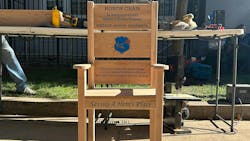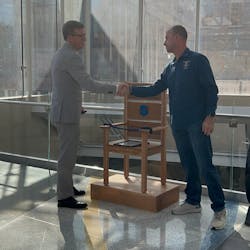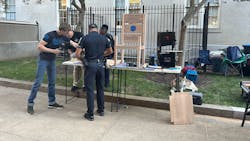The Honor Chair: Saving a Place for Fallen Officers
When it comes to honoring fallen law enforcement officers, there are individuals and organizations throughout the country that are finding new and unique ways to make sure the officer’s agency and family are supported during the grief process. One such group in Texas is using a simple idea, coupled with craftsmanship, to remember those who have paid the ultimate sacrifice.
This article appeared in the November/December issue of OFFICER Magazine. Click Here to subscribe to OFFICER Magazine.
Tommy Capell, the Executive Director of Saving a Hero’s Place, was at the National Law Enforcement Museum in Washington, D.C., in October to unveil a new Honor Chair intended to serve as a remembrance to all of the officers who have died in the line of duty. During the event, hosted by the National Law Enforcement Officers Memorial Fund, Capell spoke about how his organization got its start and how it strives to help agencies cope with tragic loss.
A simple mission
Capell began his law enforcement career with the San Antonio Police Department in 2010. That same year, one of his academy classmates, Officer Sergio Antillon, was struck and killed less than two months after they graduated. For the next four years, the department had an officer killed every year he was on the force. “I had seen it early on in my career, the sacrifice we make and risks that we take,” he says.
In 2013, a fellow officer approached him and asked if he would build a chair honoring one of the fallen officers that would take his spot in the roll call room. He didn’t personally know or had worked with the officer but decided to take on the project. “I had always done woodworking as a hobby, but it wasn’t really the type of woodworking I was used to doing,” he says. “I built the chair and gave it to him and didn’t realize what it was going to mean to those guys who worked at that substation with him.”
That April, more than two thousand miles away, The Tsarnaev brothers planted homemade pressure cooker bombs that detonated near the finish line of the Boston Marathon, killing three people and injuring hundreds. Three days later, during the manhunt for the two men, Massachusetts Institute of Technology Campus Police Officer Sean Collier was on duty in his patrol car when one of the brothers opened fire on him without warning, fatally wounding the 26-year-old.
“That incident bothered me,” says Capell. “I couldn’t sleep. I was angry.” He emailed the department, offering to build a chair in honor of the fallen officer. “I don’t think I really expected to get an email back from them, but I did. They said, ‘Absolutely, we need something. Our officers are devastated.’ ”
He began working on the chair while he and his wife, Robbie, raised money to take the trip up to Cambridge, Massachusetts, from Texas. After completing the chair, Capell, Robbie and two other officers drove more than 33 hours to deliver it to the MIT Police Department.
“When we presented that chair to them, it was the first time we realized that it was a big deal. This meant a lot to them,” he says. “His place would always be saved in the roll call room. It just kind of grew from there. On the way home, we decided to figure out how to create a non-profit. Our neighbor happened to be a CPA. It just took off. Our intention was to reach out to departments, but we get inundated with emails now, so we rarely reach out anymore.”
Built with care
For two days prior to the unveiling, of the Honor Chair at the National Law Enforcement Museum, Saving a Hero’s Place was staged outside, building the chair onsite.
“We are absolutely honored to be able to do this,” Capell said during the presentation, where he was joined by Bill Alexander, Chief Executive Officer for the National Law Enforcement Officers Memorial Fund. “We’ve been wanting to do this for some time now. It means so much to us to have this chair here in the museum.”
It was the 270th Honor Chair that Saving a Hero’s Place has created since its inception. The group has delivered at least one chair to 29 different states, and even worked with the FBI to create a chair shipped to Columbia. The organization doesn’t ask departments for money to create or deliver the chairs; it’s all done through fundraising.
This year, Saving a Hero’s Place has started going on location and building the chairs at the department. “That is so the family and fellow officers can participate in building the chair. We get input from the family and the department on the design,” he says. “We deliver every chair, regardless of where it’s at. We either drive there and build it, or we build it somewhere and still drive it to present it.”
The group received travel assistance from FinancialCop, a Texas-based firm of fiduciary financial advisors that works with law enforcement officers, first responders, and public servants. “It’s an absolute honor to have this chair here,” Capell says. “We come to National Police Week almost every year and know many names on that wall that we wish we didn’t.”
The wood memorial chairs are created to be placed in an agency’s roll call room so that after an officer dies in the line of duty, the chair takes their spot so that they always have a place at roll call. “A lot of officers, when they go to roll call, they sit in the same chair every time. It’s almost like a superstitious kind of deal. I did the same thing,” says Capell. “Our hope is to replace that empty chair with a chair specifically for them.”
In order to build the chairs, Saving a Hero’s Place starts by sourcing the wood—primarily cherry wood because it engraves and finishes better—then the lumber is sanded, engraved and painted. Finally, the Honor Chair is assembled. It takes about two full days from start to finish to build a chair.
“We’ve wanted to do this for so long,” he says of building the chair for the National Law Enforcement Officers Museum. “We came in 2015 when it first opened and wanted to build one ever since, just so that it signifies saving the place of all of our nation’s fallen. That’s why we’ve wanted to do it so badly.”
To find out more about Saving a Hero’s Place, visit savingaherosplace.org
Vist the National Law Enforcement Museum at nleomf.org/museum
About the Author
Paul Peluso
Editor
Paul Peluso is the Managing Editor of OFFICER Magazine and has been with the Officer Media Group since 2006. He began as an Associate Editor, writing and editing content for Officer.com. Previously, Paul worked as a reporter for several newspapers in the suburbs of Baltimore, MD.



